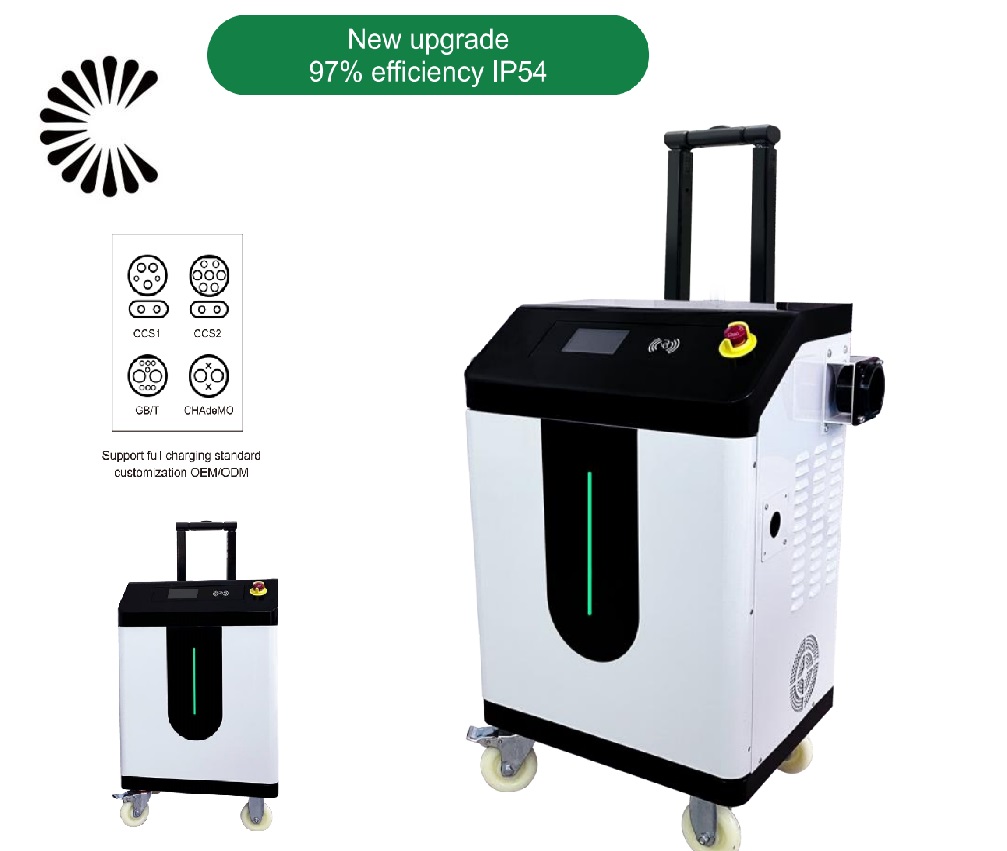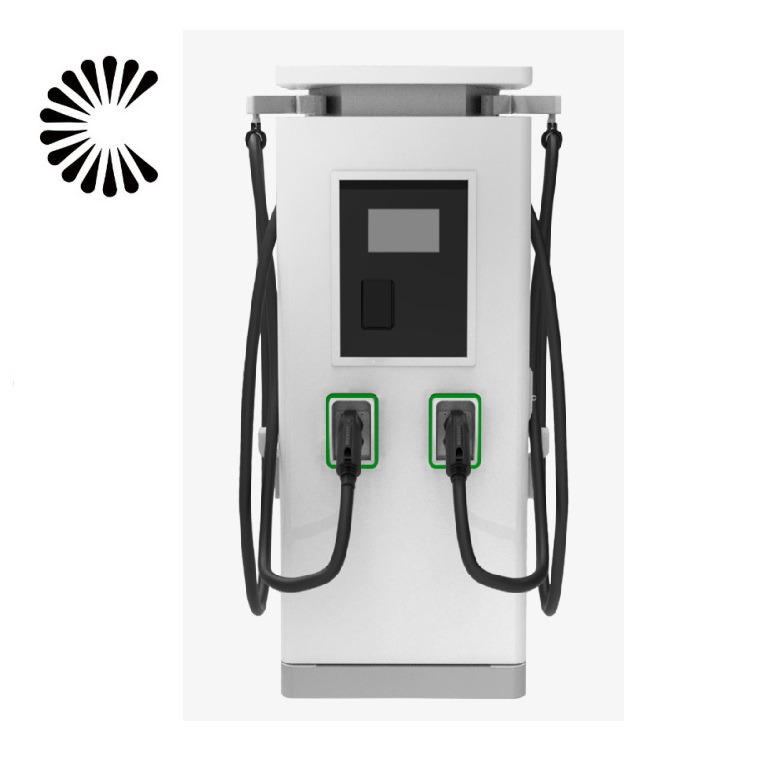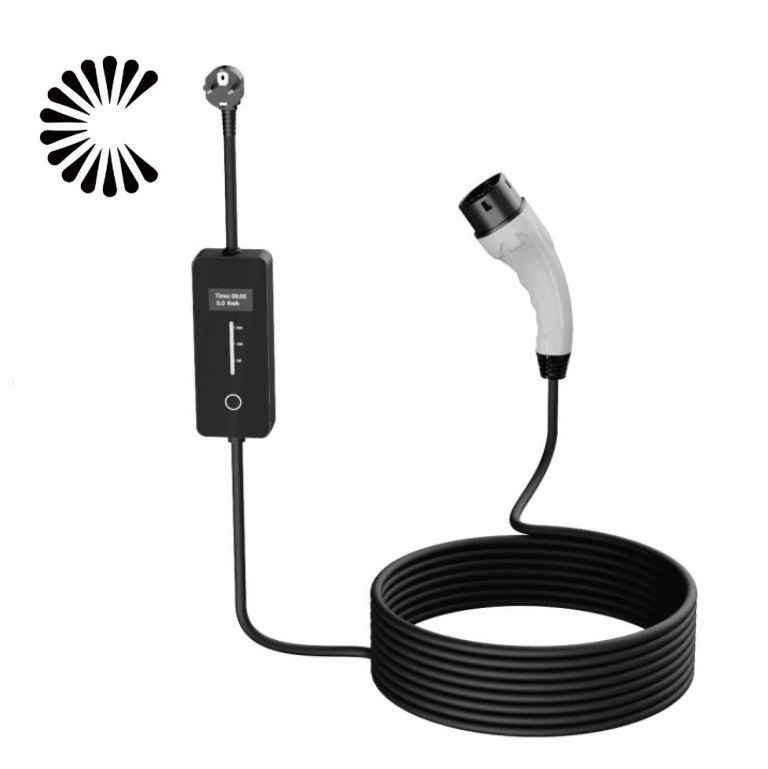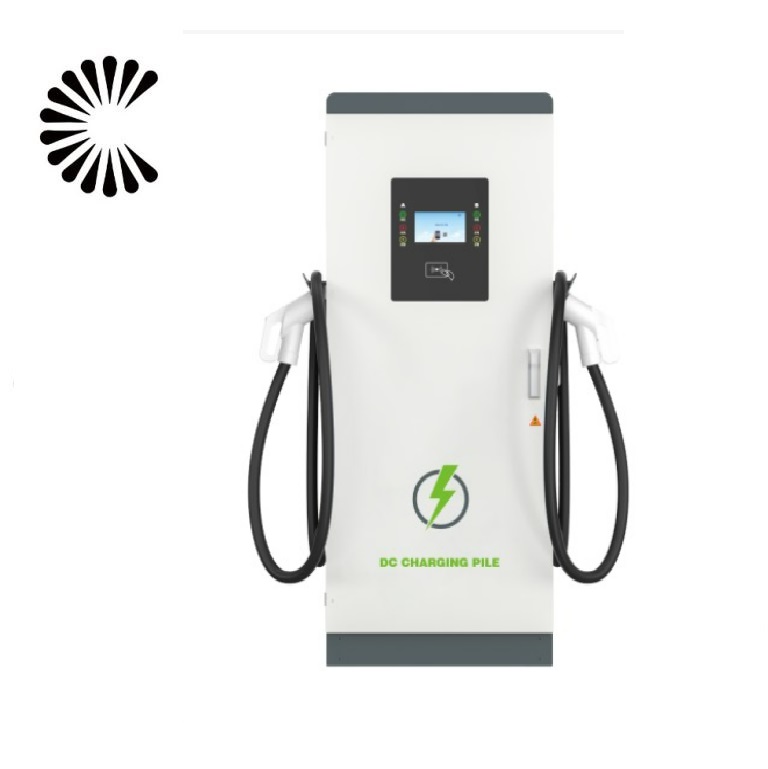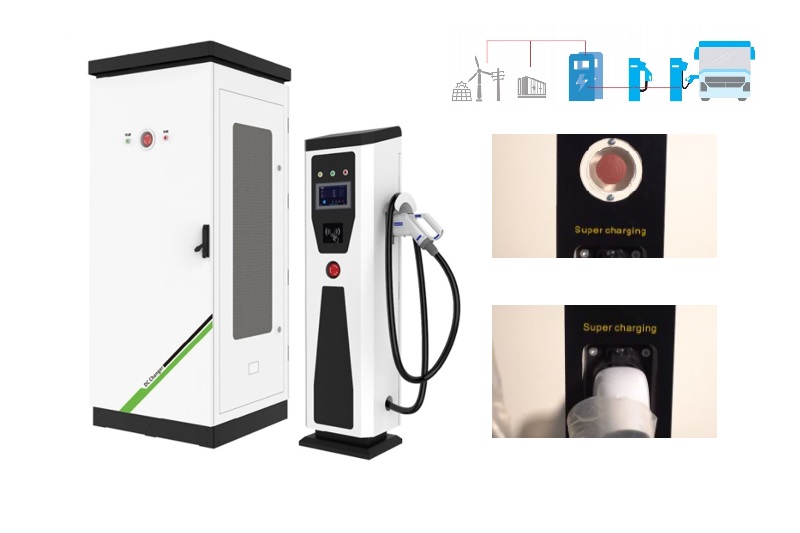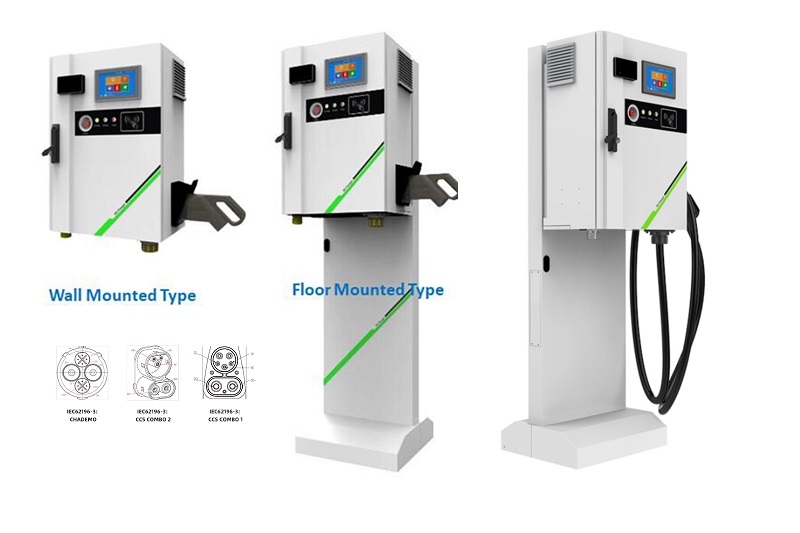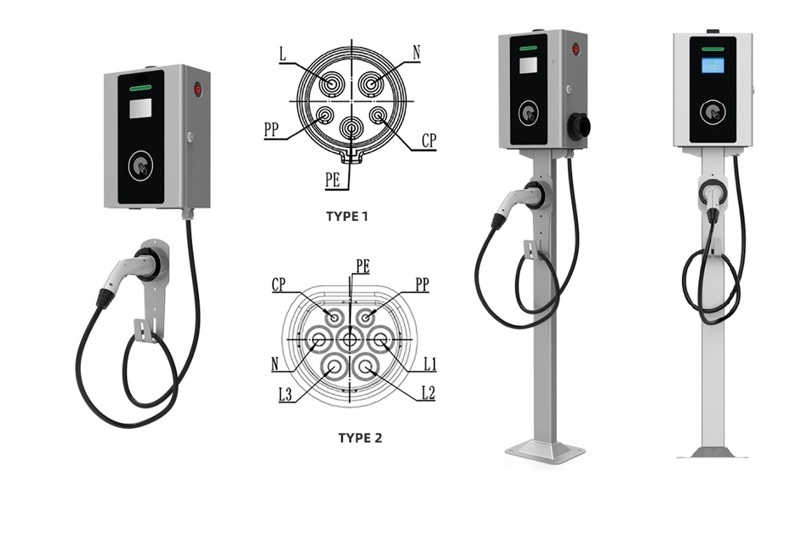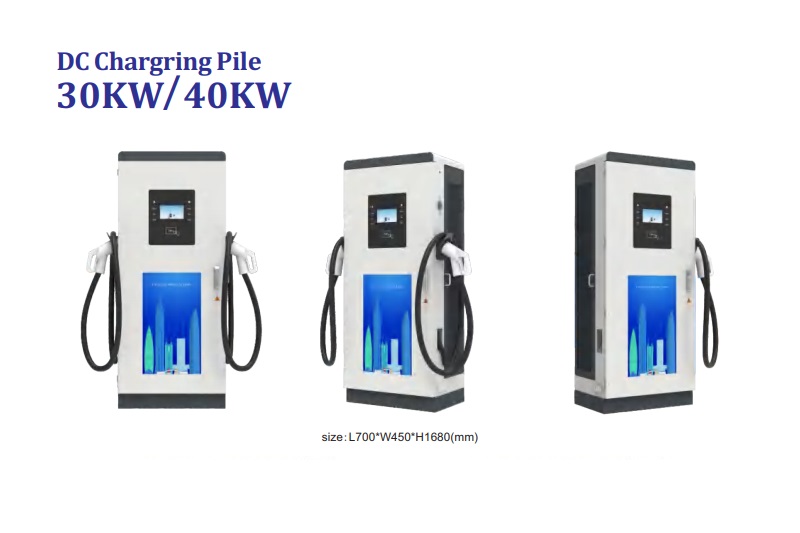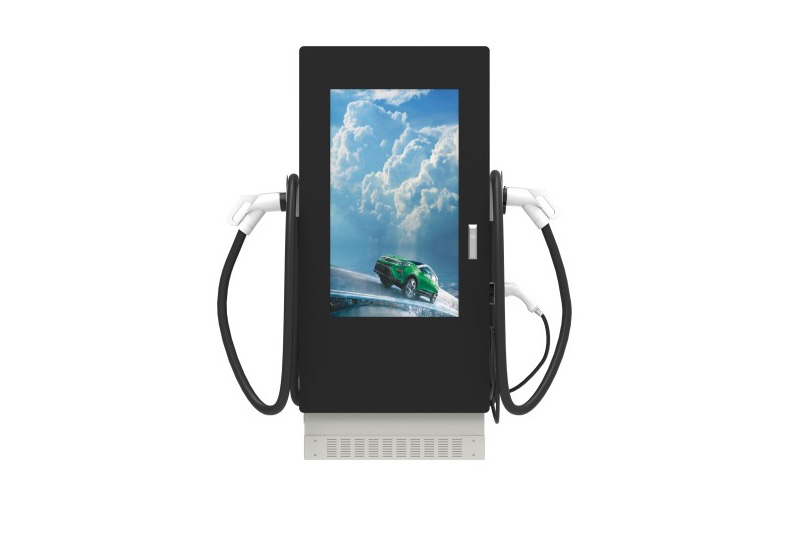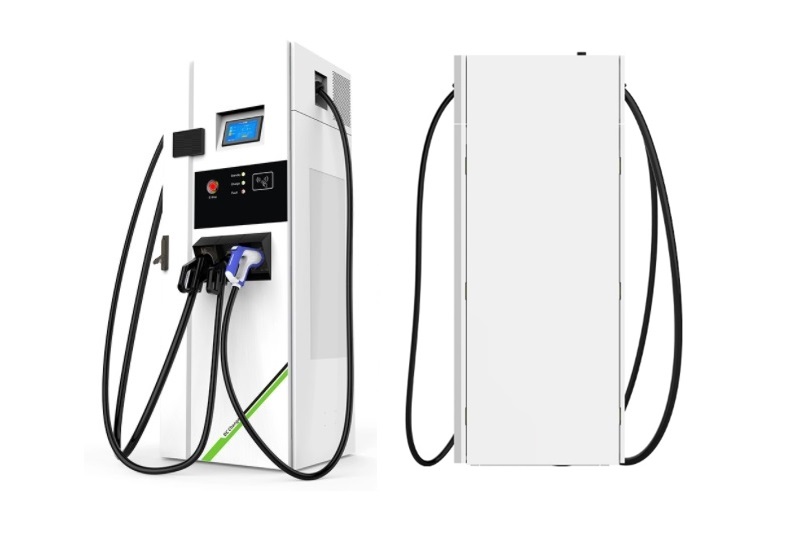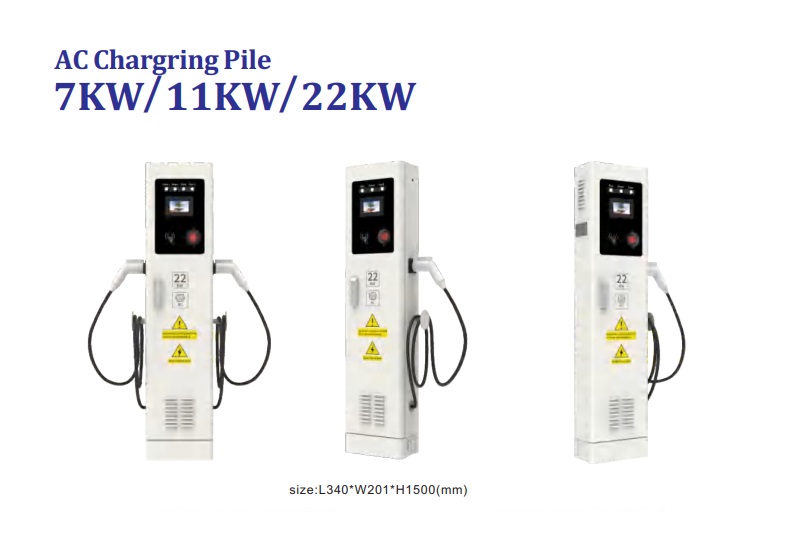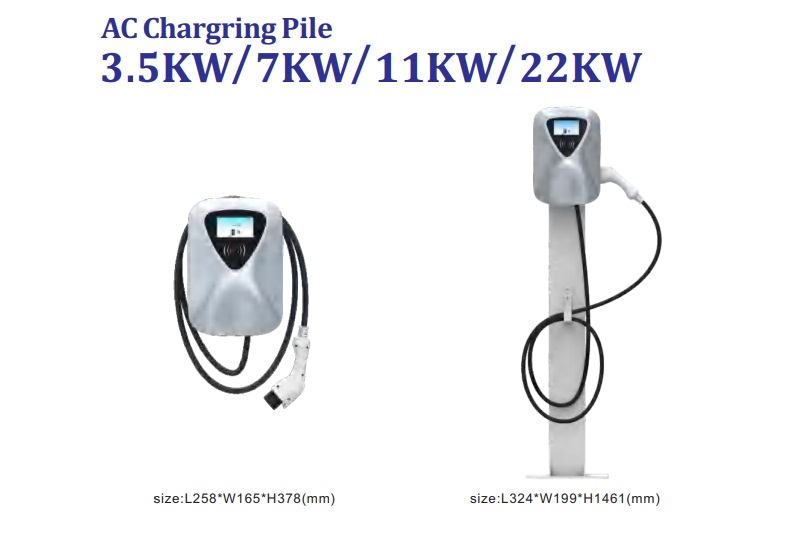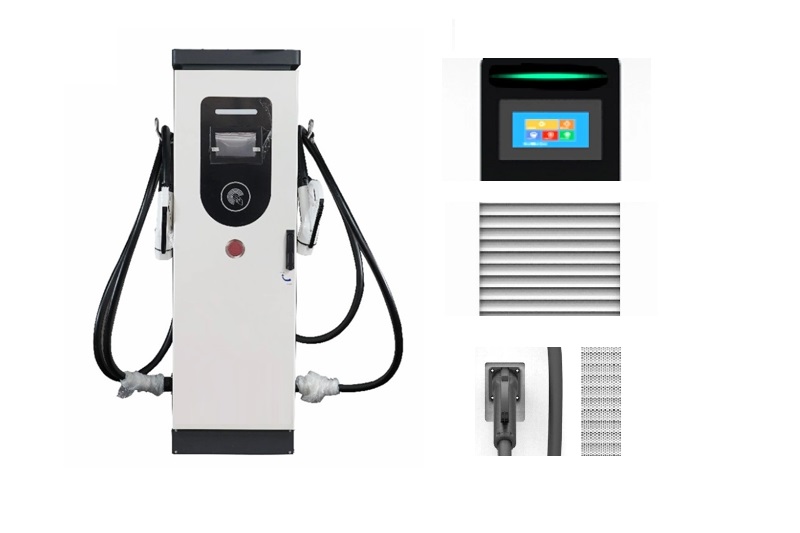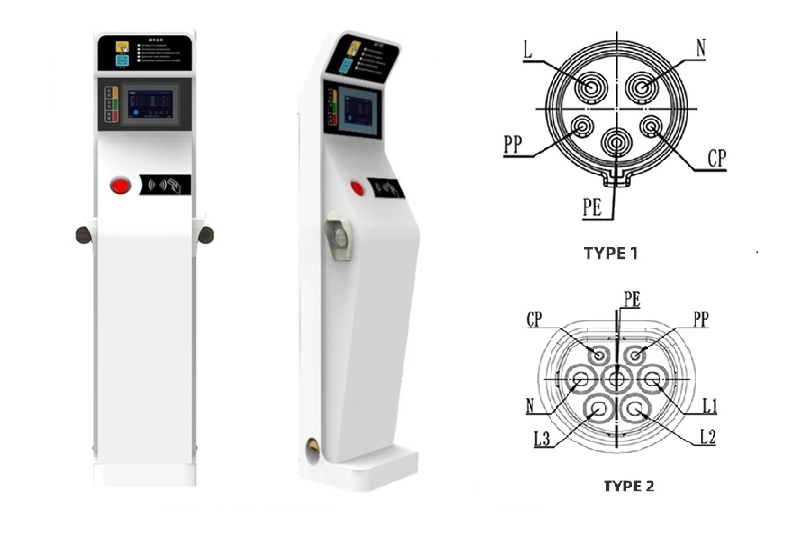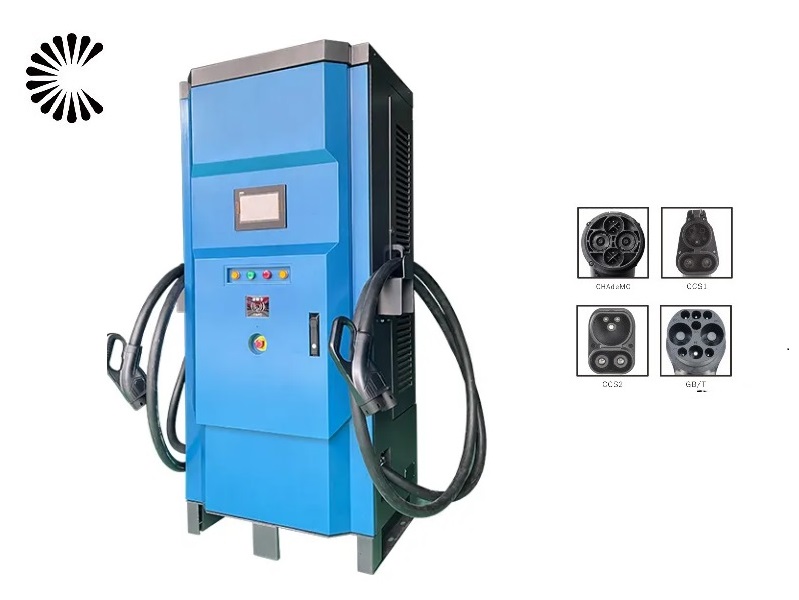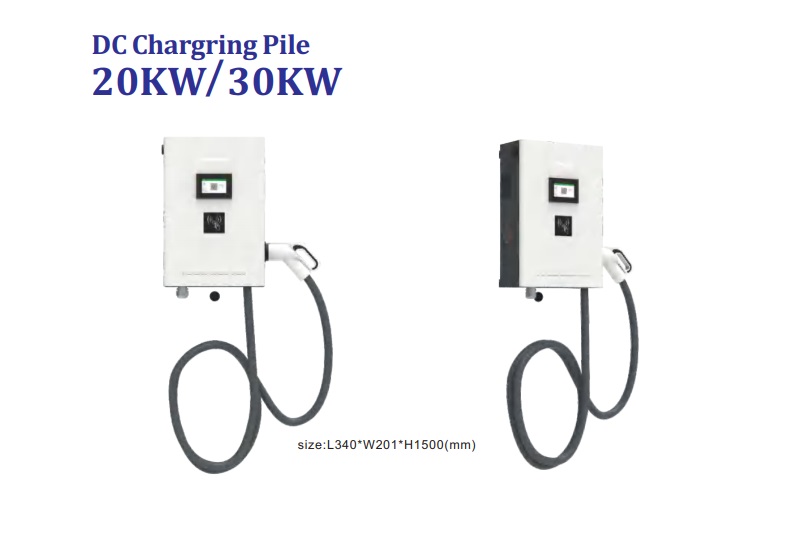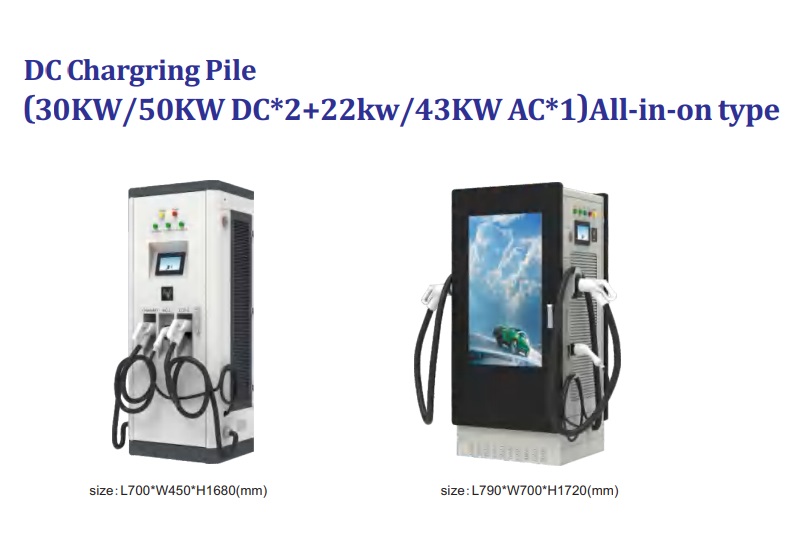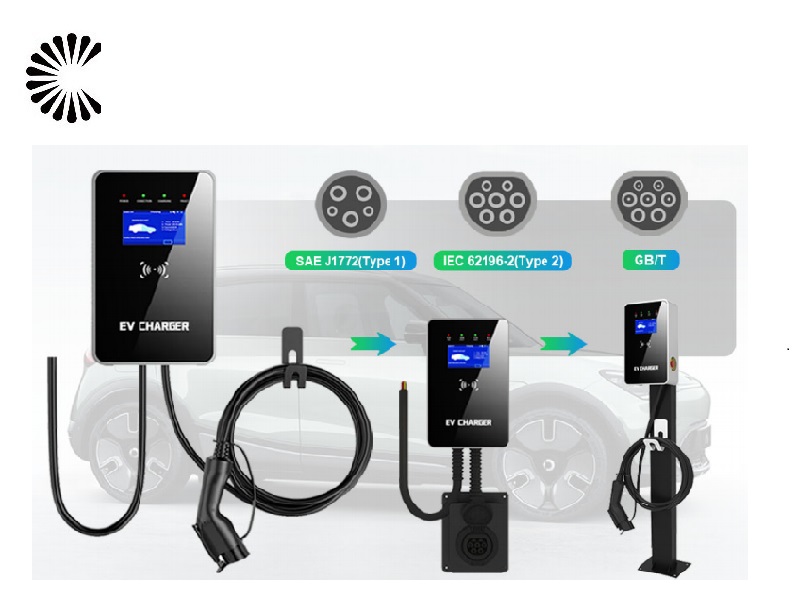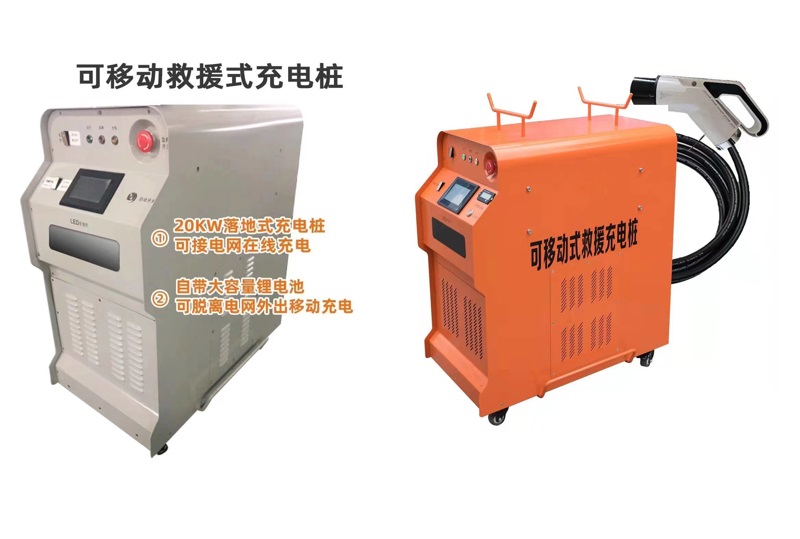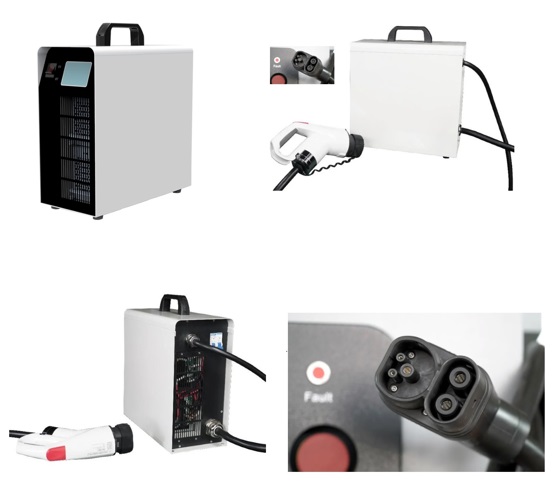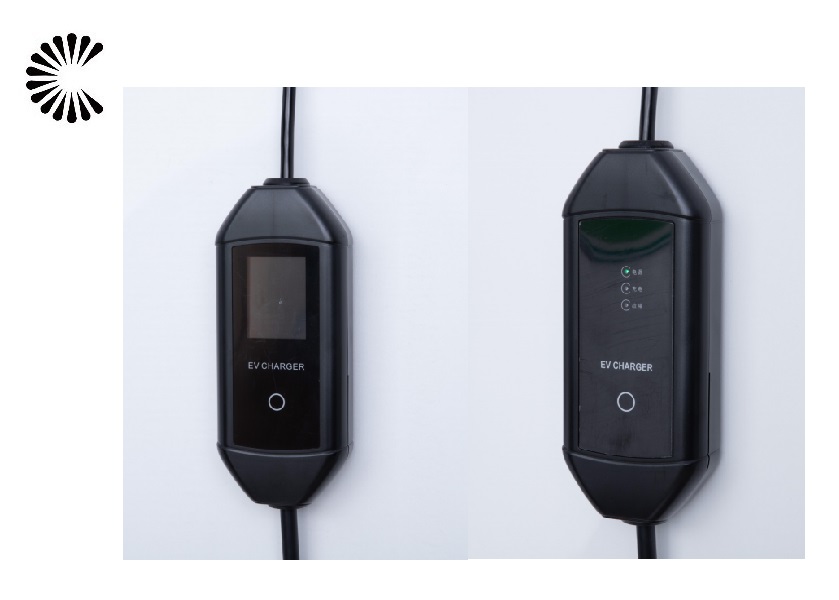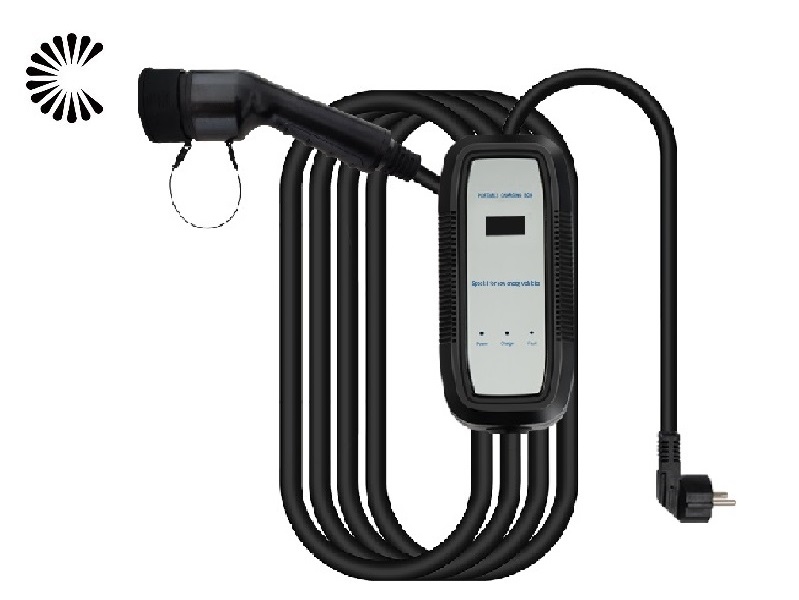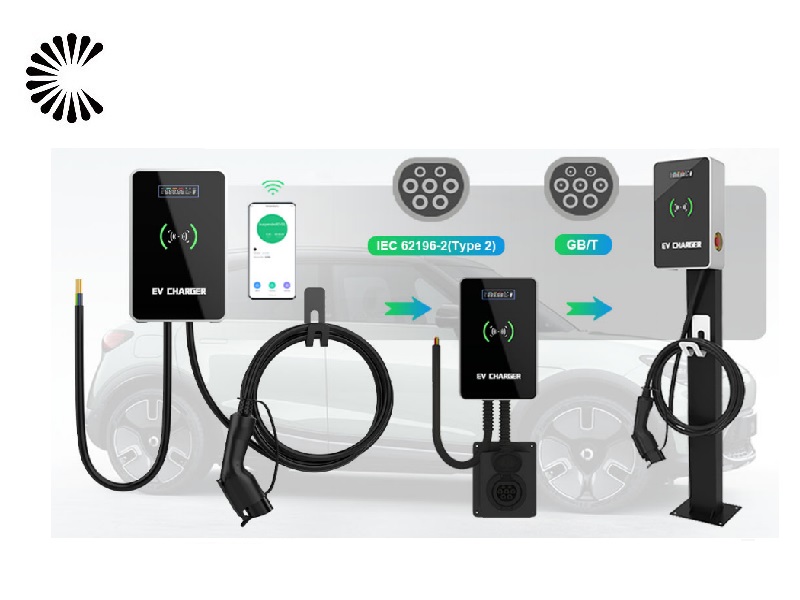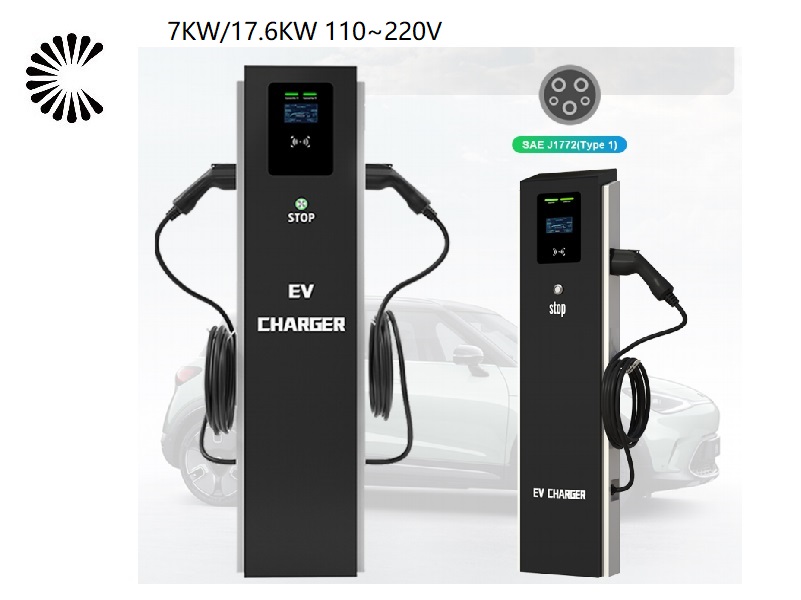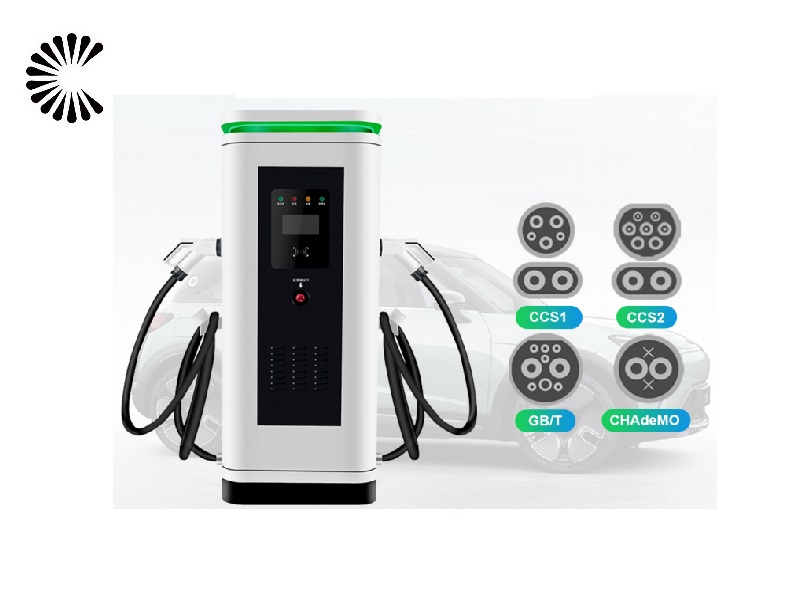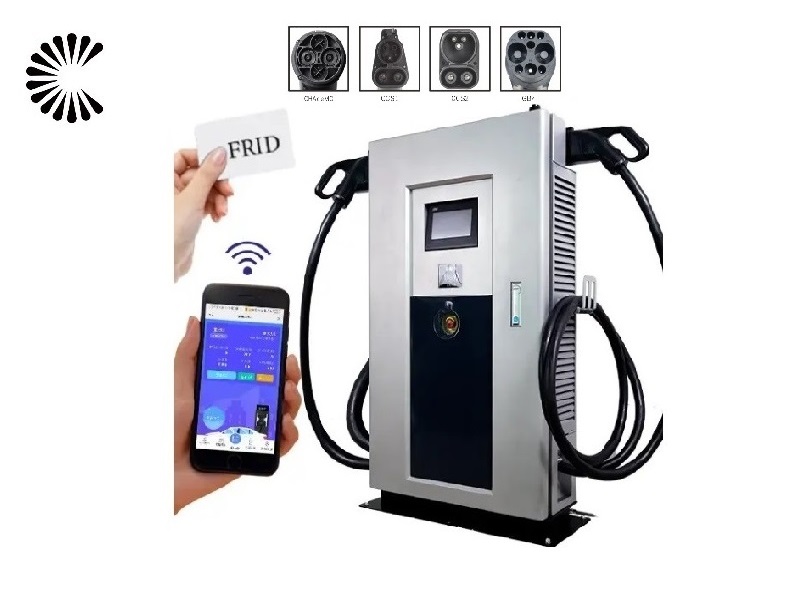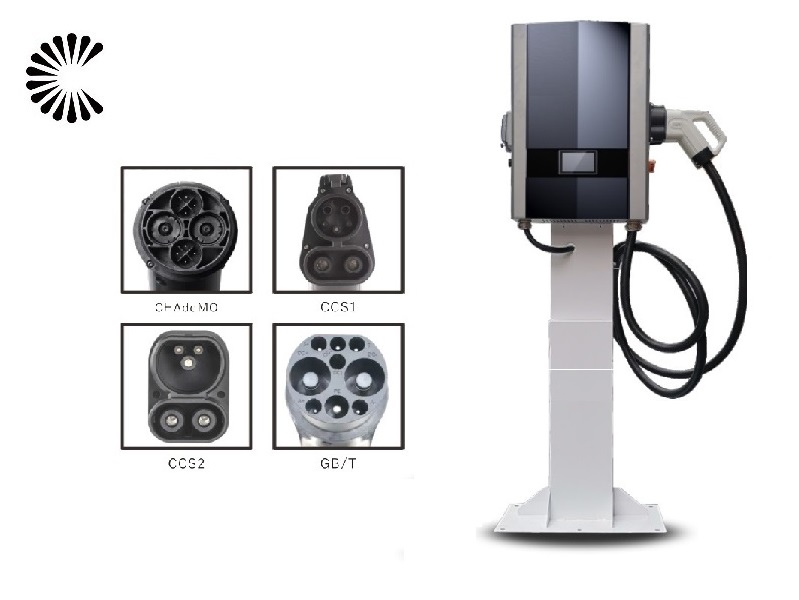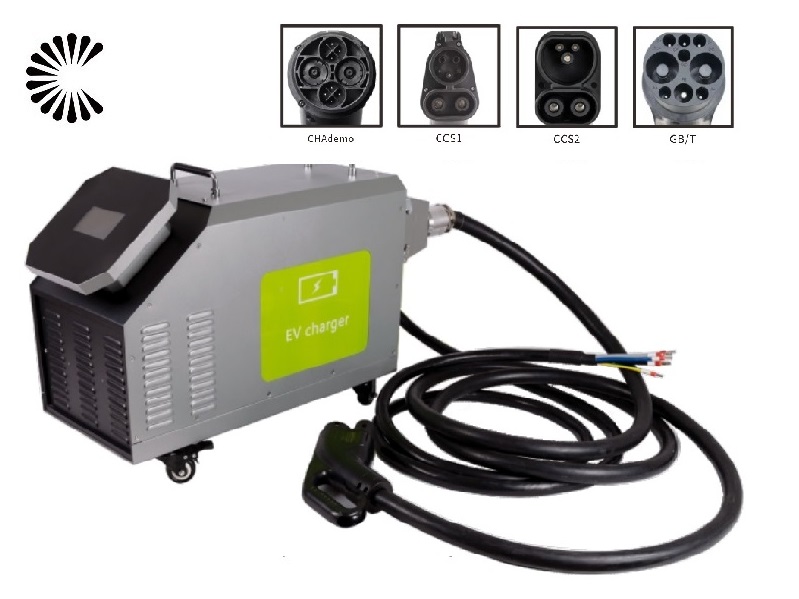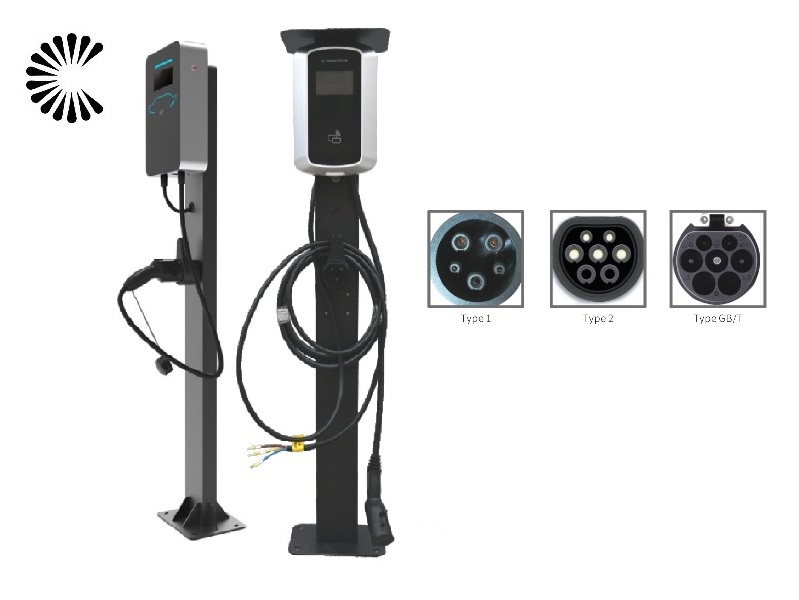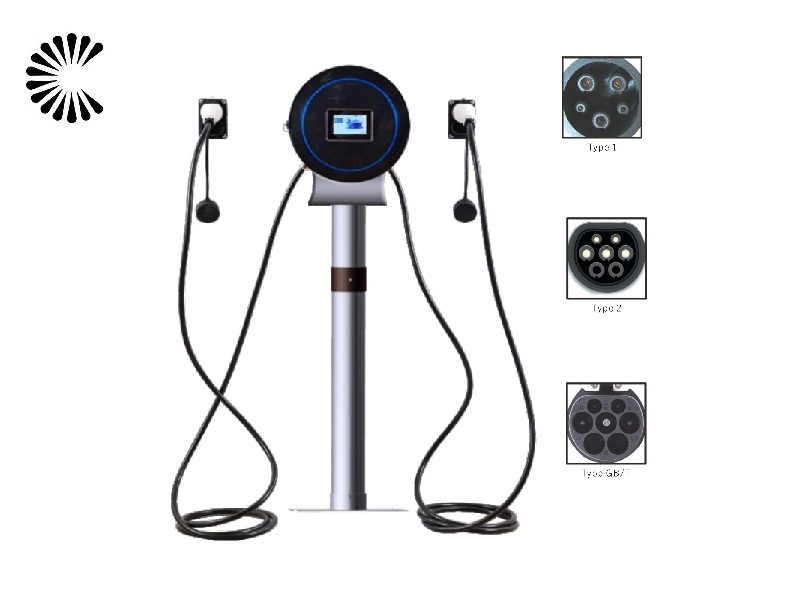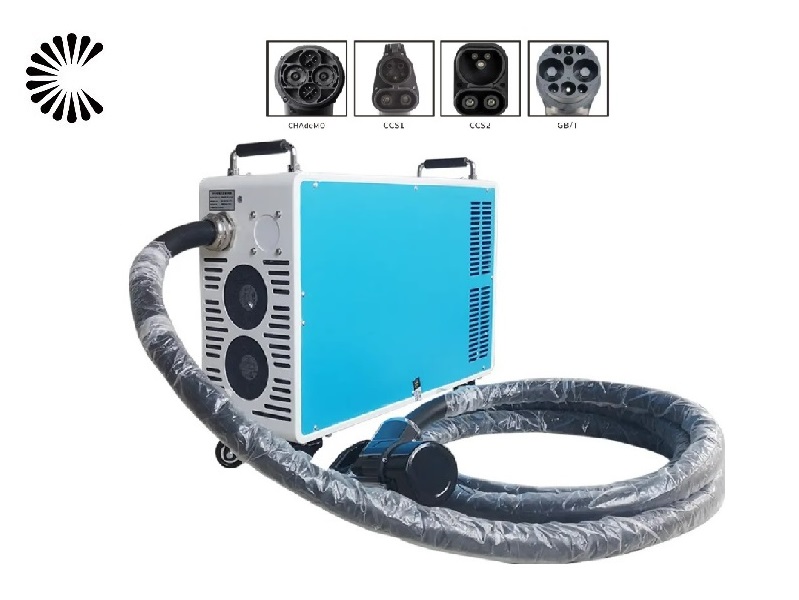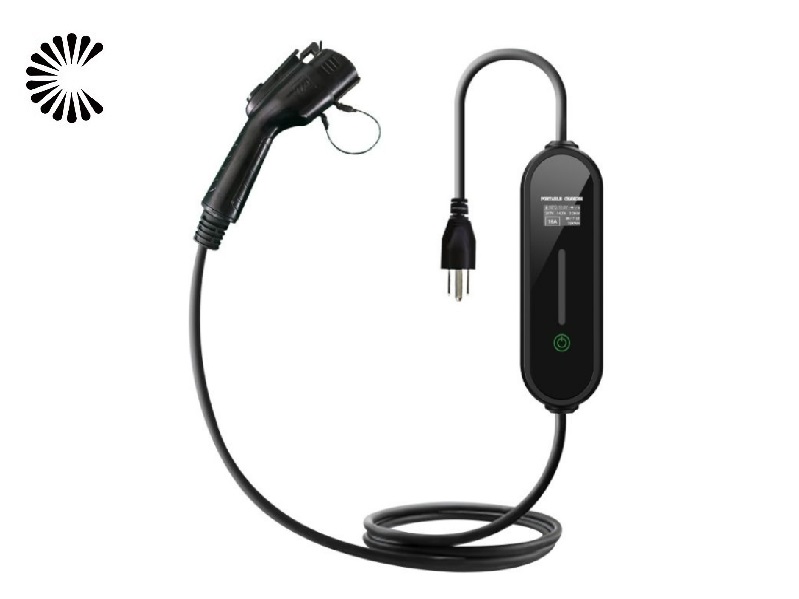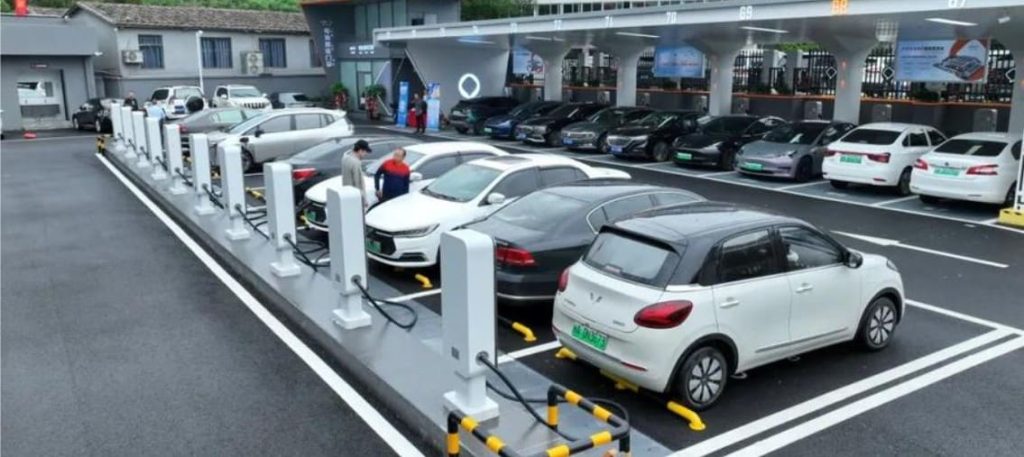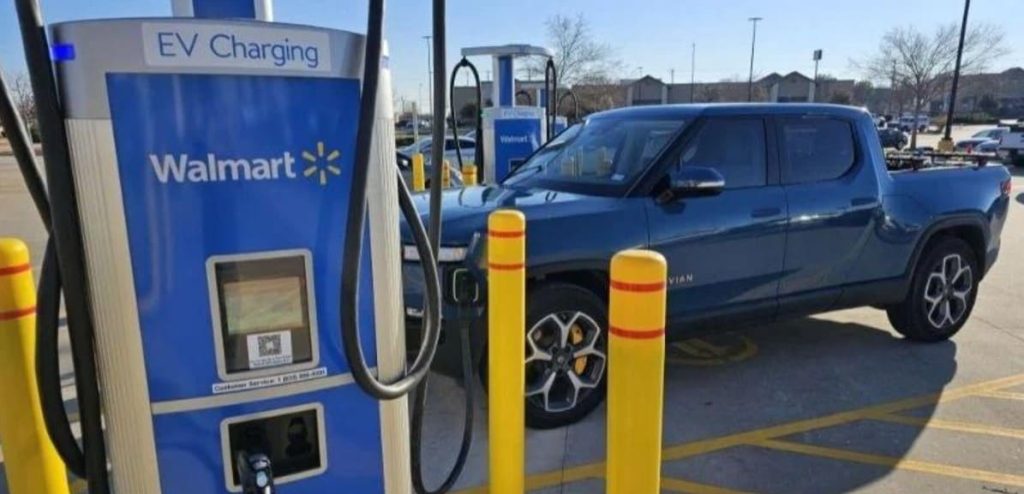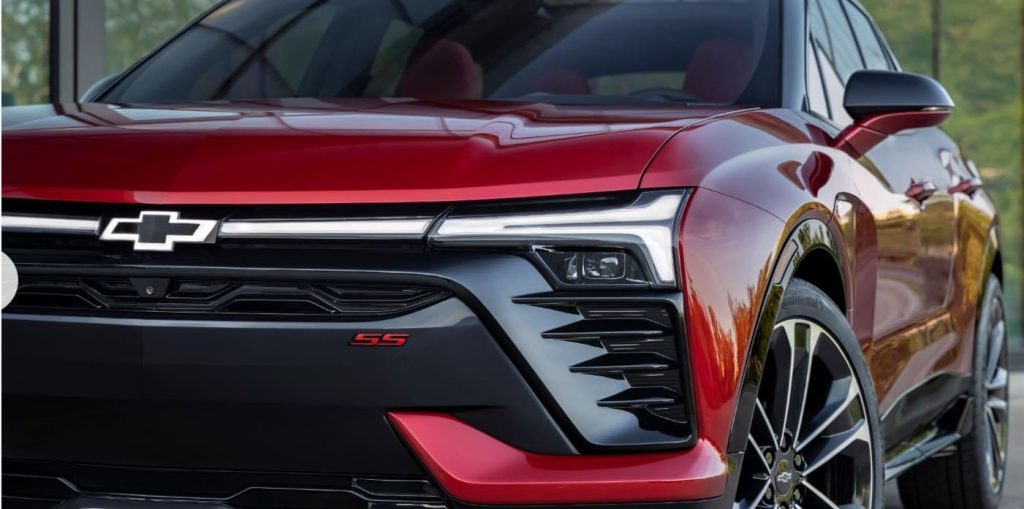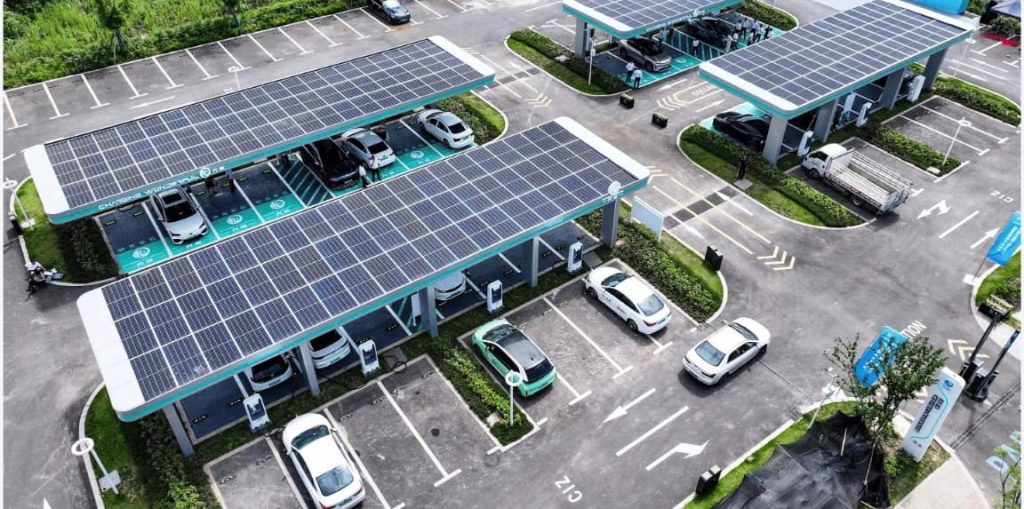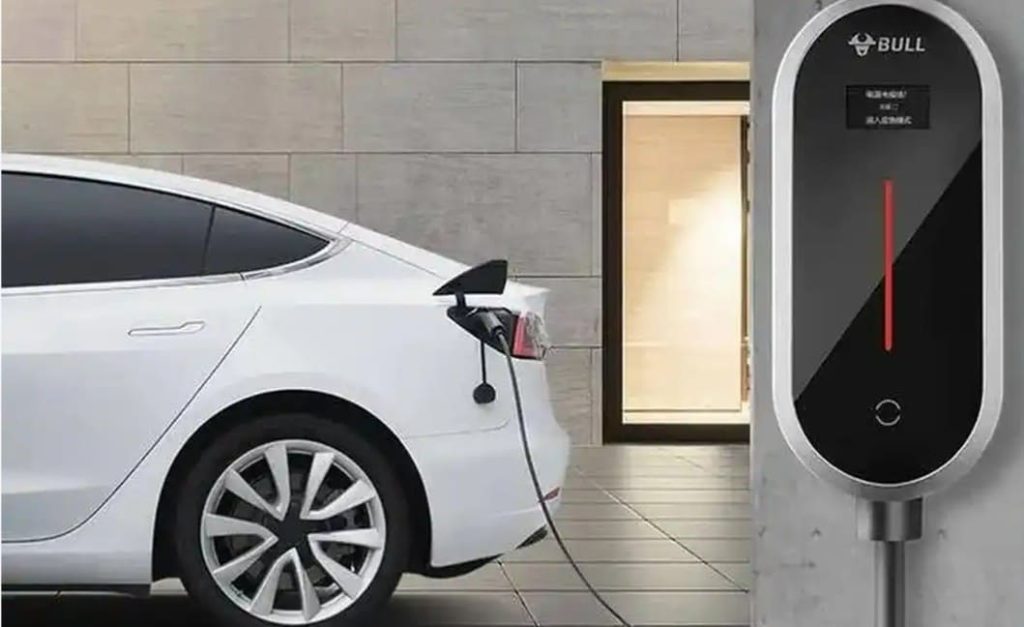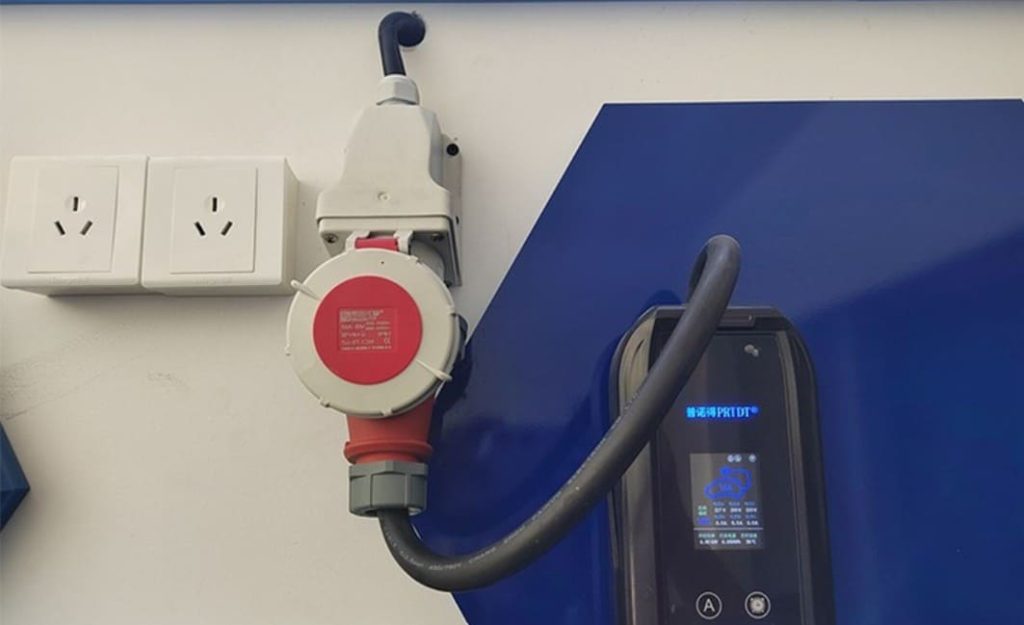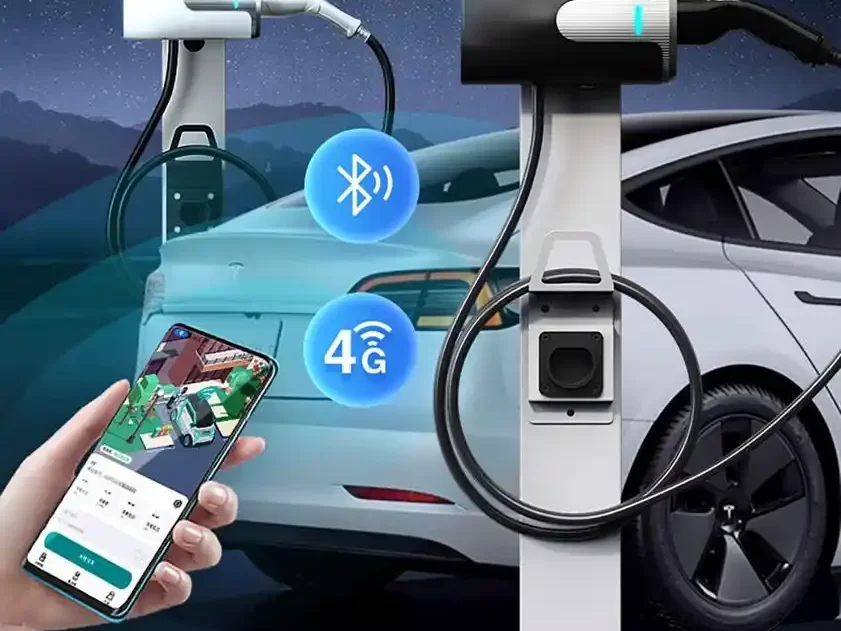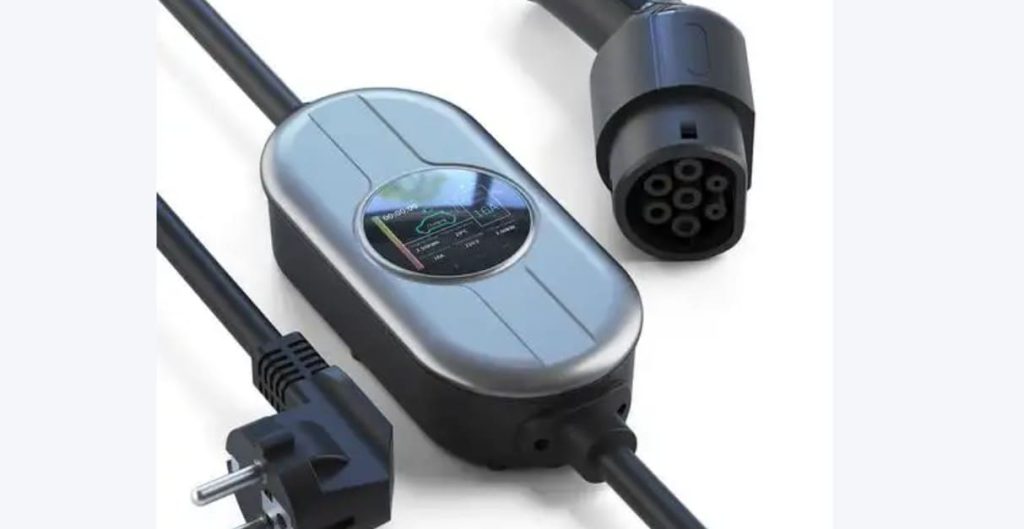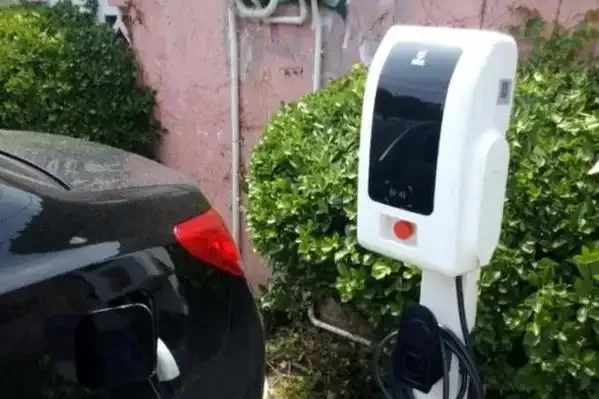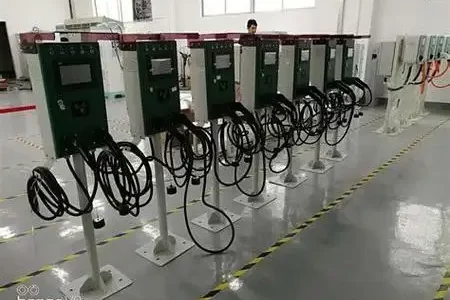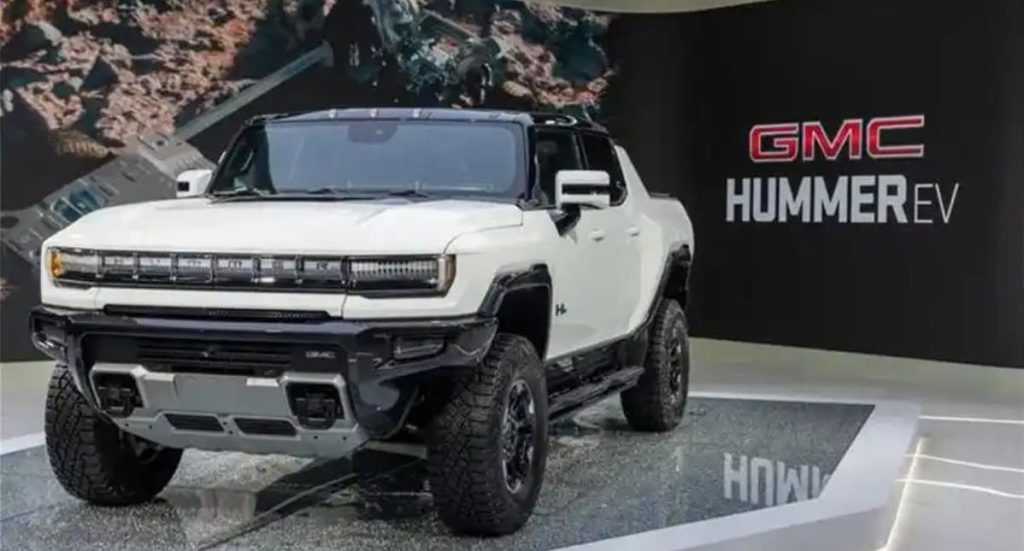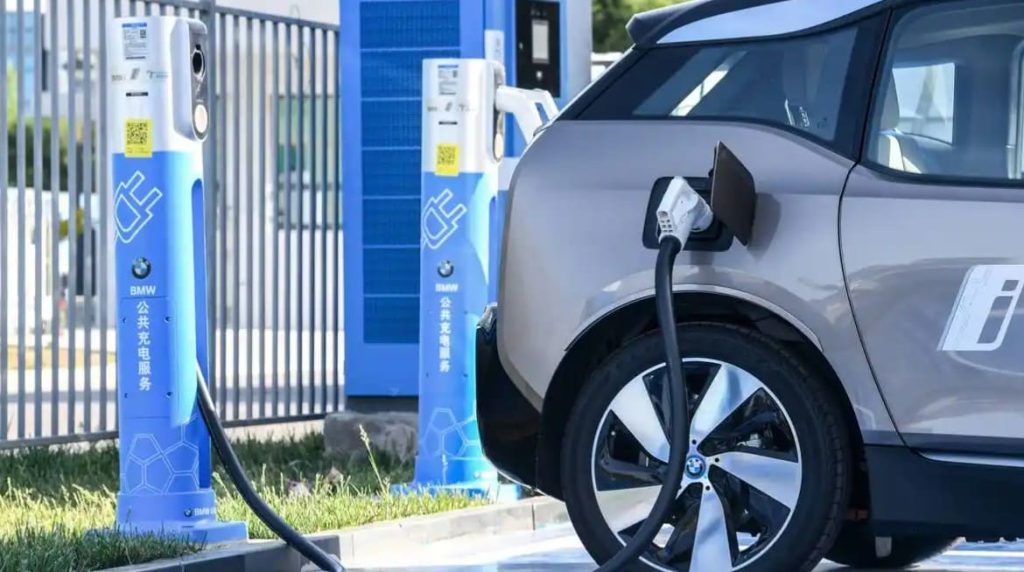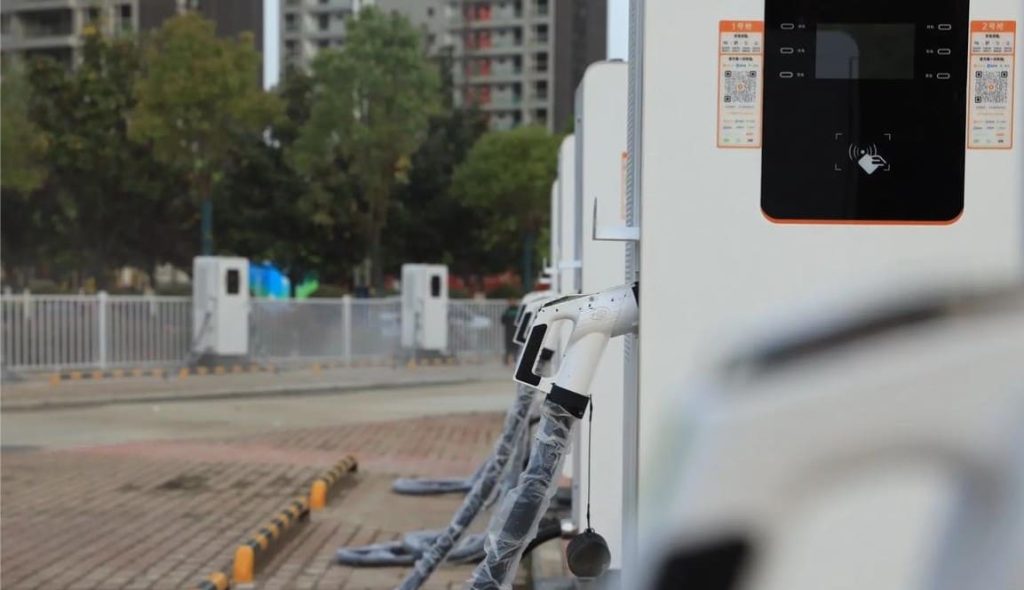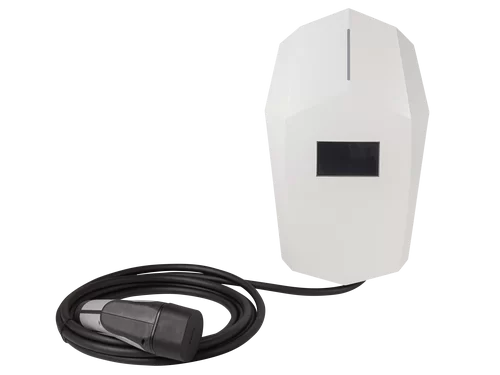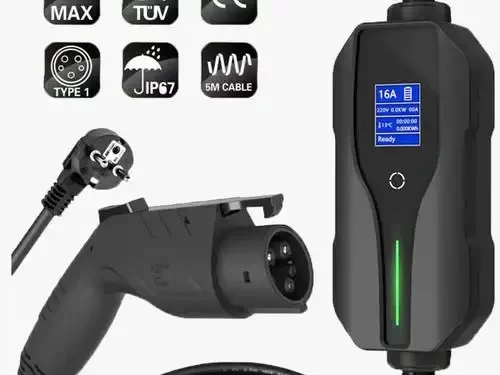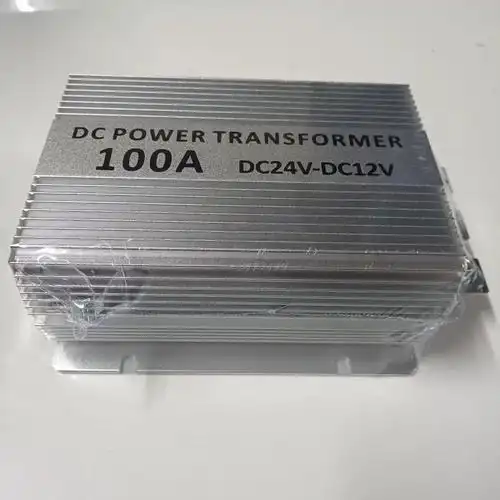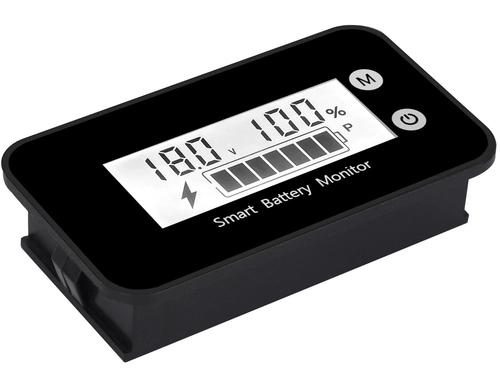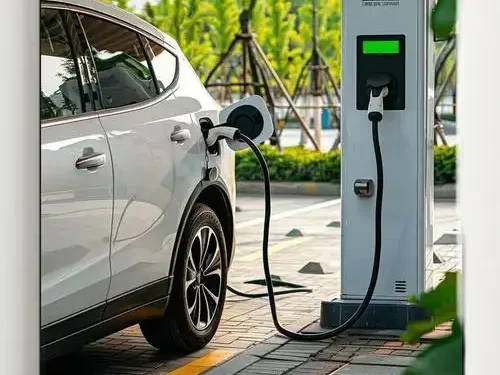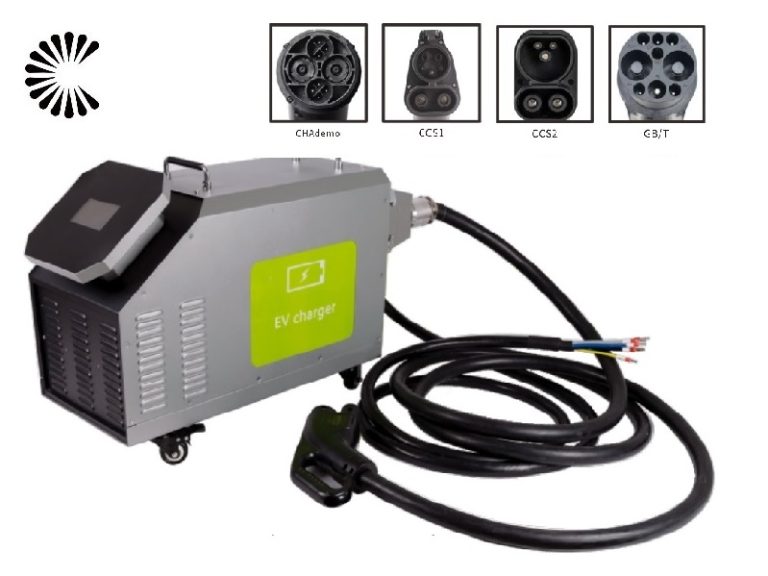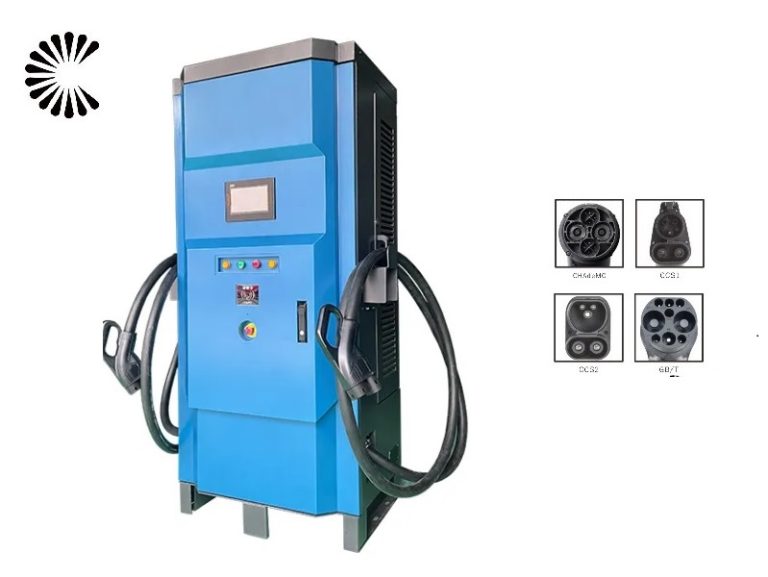220V EV Charger
Double Plug 220V EV Charger Commercial Use
Specification of 220V EV Charger
Lead time:
| Quantity (pieces) | 1 – 1 | 2 – 10 | > 10 |
| Lead time (days) | 7 | 15 | To be negotiated |
Parameters of 220V EV Charger:

Power Specification
| Category | Type1+Type1 | Type1+Type1 | Type1 |
| Power | 7KW+7KW | 17.6KW+17.6KW | 17.6KW |
| Input Max Current | 32A+32A | 80A+80A | 80A |
| Item Name | Paramters |
| Voltage | 110V~220V |
| Rated Frequency | 50/60Hz |
| Power Wiring | 3Wire-L1, N, PE |
| Connector Type | SAE J1772(Type 1) |
| Connector Mechanical Oprating Life | ≥10000 times |
User Interface &Control & Environmental
| Charging Control | Plug and play, RFID Card |
| Display Screen | 4.3-inch OLED touch screen |
| External Communication | LAN(RJ-45)/ OCPP 1.6J |
| Storage Temperature | -40 to 75℃(-40 to 167℉)ambient |
| Operating Temperature | -30 to 55℃(-22 to 131℉)ambient |
| Operating Humidity | Up to 95% non-condensing |
| Altitude | ≤2000m |
| Cooling Method | Natural Cooling |
| Protection Rating | IP54 |
| Under Voltage Protection | Yes |
| Short Circuit Protection | Yes |
| Ground Protection | Yes |
| Surge Protection | Yes |
| Type A RCD Built-in (Type B Optional) | Yes |
| Over Voltage Protection | Yes |
| Over Load Protection | Yes |
| Earth Leakage Protection | Yes |
| Over-temp Protection | Yes |
Introduction of 220V EV Charger
Electric vehicles (EVs) are becoming increasingly popular as a sustainable and eco-friendly mode of transportation. To keep these vehicles running efficiently, a reliable and fast charging infrastructure is essential. One crucial component of this infrastructure is the 220V EV charger.
The 220V EV charger, also known as Level 2 charging, is a charging solution designed to power up electric vehicles with greater speed and efficiency than standard household outlets. Unlike the typical 110-volt outlets found in homes, the 220V charger operates at a higher voltage and delivers more power to the vehicle’s battery.
With the 220V EV charger, EV owners can experience significant benefits in terms of charging time and convenience. Compared to Level 1 charging, which may take several hours to recharge a vehicle fully, the 220V charger can drastically reduce charging time, making it an ideal option for daily charging needs.
Installing a Level 2 charging station at home or other strategic locations offers added flexibility for EV owners. It allows them to charge their vehicles faster, giving them more freedom to explore longer distances without worrying about running out of battery power.
Furthermore, the 220V EV charger is compatible with a wide range of electric vehicles, making it a versatile choice for most EV owners. It comes with various connector options, ensuring that EVs from different manufacturers can easily plug in and charge.
In addition to being practical and efficient, the 220V EV charger contributes to a greener future. By encouraging the use of electric vehicles and providing faster charging, we can reduce our reliance on fossil fuels and decrease harmful emissions, ultimately contributing to a cleaner and more sustainable environment.
As the demand for electric vehicles continues to grow, the importance of a robust charging infrastructure cannot be understated. The 220V EV charger plays a vital role in supporting the widespread adoption of electric vehicles, paving the way for a cleaner, greener, and more sustainable transportation future.
Advantages of 220V EV Charger
The 220V EV charger, also known as Level 2 charging, offers several advantages that make it a popular choice for electric vehicle (EV) owners:
Faster Charging:
One of the main advantages of the 220V EV charger is its faster charging speed compared to the standard 110-volt household outlet (Level 1 charging). With Level 2 charging, your EV’s battery can be replenished more quickly, reducing charging time significantly.
Convenient for Daily Use:
The increased charging speed of the 220V EV charger makes it more convenient for daily use. It allows you to recharge your EV overnight or during the day, so your vehicle is ready to go whenever you need it.
Suitable for Longer Journeys:
For longer journeys or road trips, the 220V EV charger becomes invaluable. It enables you to top up your vehicle’s battery at public charging stations more efficiently, reducing charging stops and making long-distance travel with an EV more practical.
Home Charging Solution:
Installing a 220V EV charger at home is a common choice for EV owners. It provides a dedicated charging station in your garage or parking space, allowing you to charge your EV conveniently and reliably.
Versatile Compatibility:
Most EV models support Level 2 charging, and the 220V EV charger comes with various connector options to match different EVs. This compatibility makes it a versatile choice for many electric vehicle owners.
Cost-Effective Charging:
Despite its faster charging capability, the 220V EV charger is still cost-effective. It strikes a balance between charging speed and installation costs compared to even faster chargers like DC fast chargers (Level 3).
Promotes Sustainable Driving:
Utilizing a 220V EV charger encourages the adoption of electric vehicles, contributing to a greener and more sustainable transportation future. By reducing reliance on fossil fuels, EVs and their efficient chargers help to decrease harmful emissions and combat climate change.
Off-Peak Charging Benefits:
Many electric utility companies offer off-peak electricity rates, making charging with a 220V EV charger more economical during specific times of the day when electricity demand is lower.
In conclusion, the 220V EV charger provides faster charging, convenience, and versatility, making it an excellent choice for EV owners. It supports sustainable driving practices and facilitates the widespread adoption of electric vehicles, contributing to a cleaner and more environmentally friendly world.
| Business Type: | Manufacturer/Factory | Main Products: | EV Charger |
| Number of Employees: | 100 | Year of Establishment: | 2014.05 |
| Production Capacity | 5000Set/Year | After-sales Service: | Technical Support; on-line teach lessons |
| R&D Capacity: | ODM, OEM | Annual Output Value: | US$5 Million – US$10 Million |
| No. of R&D Staff: | 5 | No. of Production Lines: | 6 |
ChargersGO is a professional manufacturer for EV Charger. Our main product including slow charger, fast charger, DC EV Charger, AC EV Charger, commercial EV Charger, charger for home, EV charger level 1, level 2 and level 3 etc. All products in accordance with the China GMP design requirements. And also we have other certifications.
Business Philosophy
“Quality is the main policy of sales” and “integrity is the principle of success” are the business philosophy of our people. We carry out one-year warranty, lifelong maintenance service, with technical consultation and other services, and long-term supply of equipment. Welcome new and old customers to negotiate cooperation!

Small Machine Packing:
Retail Small EV Charger shipped with express.
Wsholesale Small EV Charger packed with export fumigation-free wooden cases, goes with bulk shipment or in container.
When packing small machines for sea shipment, it is important to take measures to ensure that the machines are protected from damage during transit. Here are some general steps that a manufacturer may follow when packing small machines for sea shipment:
- Clean and dry the charger: Before packing, the charger should be thoroughly cleaned and dried to prevent any moisture or debris from causing damage during transit.
- Disassemble the machine: If possible, the charger should be disassembled into its component parts to reduce its overall size and make it easier to pack.
- Wrap the charger in protective material: The charger should be wrapped in a layer of protective material, such as bubble wrap or foam, to protect it from scratches and impact during transit.
- Place the charger in a sturdy box: The wrapped charger should then be placed in a sturdy box that is appropriate for the size and weight of the machine. The box should be made of durable material, such as corrugated cardboard or plywood, and should be able to withstand the rigors of sea transit.
- Add packing material: The box should be filled with packing material, such as packing peanuts or air pillows, to provide cushioning and prevent the machine from shifting during transit.
- Seal the box: The box should be securely sealed with high-quality packing tape to prevent it from opening during transit.
- Label the box: The box should be clearly labeled with the charger’s name, weight, and any other relevant information, as well as the destination address and contact information.
Overall, the goal is to pack the small chargers in a way that will protect it from damage during transit and ensure that it arrives at its destination in good condition. It is important to follow proper packing procedures and use high-quality packing materials to minimize the risk of damage during sea shipment.
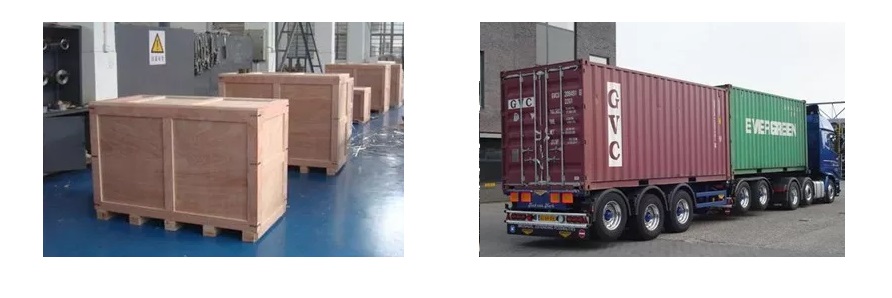
Large Machine Packing:
Packing a large machine for sea shipment can be a complex and challenging task. However, with careful planning and attention to detail, it is possible to pack a large machine for sea shipment in a way that will ensure that it arrives at its destination in good condition. Here are some general steps that a manufacturer may follow when packing up a large machine for sea shipment:
- Clean and prepare the machine: Before packing, the machine should be thoroughly cleaned and prepared. All fluids, such as oil or coolant, should be drained, and any loose or detachable parts should be removed.
- Disassemble the machine: If possible, the machine should be disassembled into its component parts to reduce its overall size and make it easier to pack. Each part should be carefully labeled and numbered to ensure that it can be easily reassembled at the destination.
- Protect delicate parts: Delicate or fragile parts should be wrapped in protective material, such as bubble wrap or foam, to protect them from damage during transit.
- Build a custom crate: A custom crate should be built around the machine to provide a secure and sturdy enclosure. The crate should be made of durable material, such as plywood, and should be designed to fit the machine snugly. The crate should also include braces or supports to prevent the machine from shifting during transit.
- Add cushioning material: The crate should be filled with cushioning material, such as packing peanuts or air pillows, to provide extra protection and prevent the machine from moving or shifting during transit.
- Securely fasten the machine: The machine should be securely fastened to the crate to prevent it from moving or shifting during transit. This may involve using straps, bolts, or other fasteners to hold the machine in place.
- Seal and label the crate: The crate should be securely sealed with high-quality packing tape, and should be clearly labeled with the machine’s name, weight, and any other relevant information. The destination address and contact information should also be clearly marked on the crate.
Overall, packing a large machine for sea shipment requires careful planning and attention to detail. It is important to use high-quality materials and follow proper packing procedures to ensure that the machine arrives at its destination in good condition. A professional packing and shipping company may be consulted to ensure that the machine is properly packed and prepared for sea shipment.
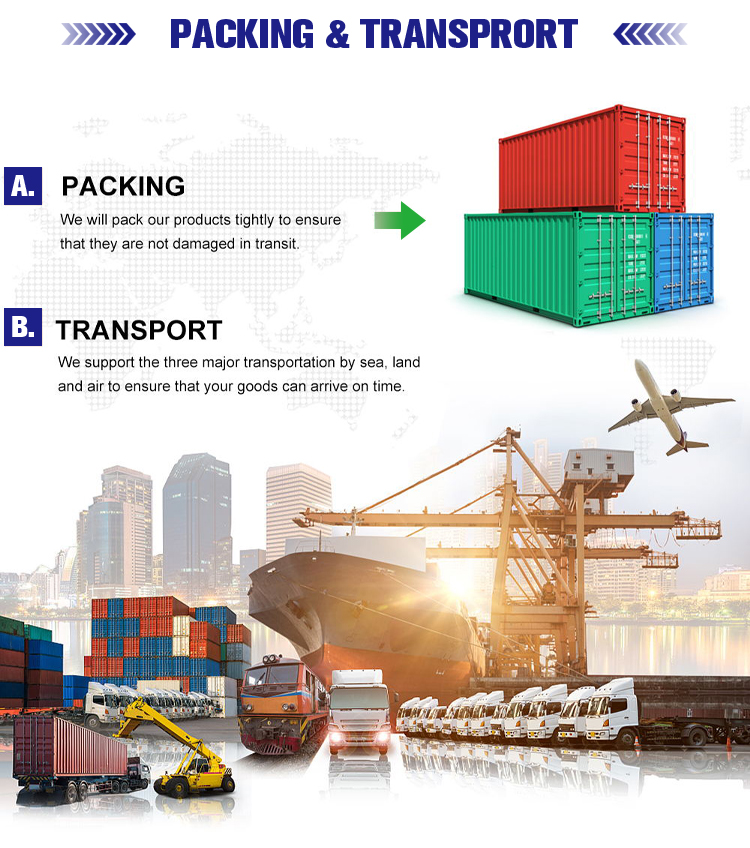
220V EV Charger Wholesale Manufacturer In China
220V EV Charger is suitable for both home and commercial outdoor use. We are wholesale manufacturer for 220V EV Charger, we have several models of 220V Ev Charger, including DC and AC EV Charger. Able to customize the spec and paramters, brands according to your request. Please contact with our sales team for more informations.
Related Products
Related Articles
Contact Us
Frequently Asked Questions (See More FAQ)
-
Are you a factory or trading company?
We are a professional manufacturer of new and sustainable energy applications for over 20 years.
-
What is the warranty?
Warranty period is 12 months. In this period, we will supply technical support and replace the new parts by free,customers are in charge of delivery.
-
What is the packing method?
Generally, we pack our goods in brown cartons. If you have legally registered patent, we can pack the goods in your branded boxes after getting your authorization letters.
-
What is your terms of payment?
T/T 50% as deposit, and 50% before delivery. We’ll show you the photos of the products and packages before you pay the balance.
-
What is your terms of trade?
EXW, FOB, CFR, CIF, DAP,DDU,DDP
-
How about your delivery time?
Generally, it will take 3 to 7 working days after receiving your advance payment. The specific delivery time depends on the items and the quantity of your order.
-
Can you produce according to the samples?
Yes, we can produce by your samples or technical drawings. We can build the molds and fixtures.
-
What is your sample policy?
We can supply the sample if we have ready parts in stock, but the customers have to pay the sample cost and the courier cost.
-
Do you test all your goods before delivery?
Yes, we have 100% test before delivery.
-
Can you charge an EV with a 220 outlet?
Yes, you can charge an electric vehicle (EV) with a 220-volt outlet. Many EVs are designed to be charged using a 220-volt electrical supply, which is commonly referred to as Level 2 charging. This type of charging is faster than using a standard 110-volt household outlet, which is known as Level 1 charging.
To charge your EV with a 220-volt outlet, you will need to use a Level 2 EV charger or charging station. This charger can be installed at your home, workplace, or other convenient locations. When you plug your EV into the Level 2 charger, it will draw power from the 220-volt outlet and charge your vehicle’s battery.
Using a Level 2 charger with a 220-volt outlet can significantly reduce charging time compared to Level 1 charging. It allows you to recharge your EV more quickly and efficiently, making it a popular choice for EV owners who want to charge at home or while they are parked at a destination for an extended period.
Keep in mind that the charging speed and time will vary depending on your EV’s battery size and the charging capacity of the Level 2 charger. Always check your vehicle’s manual or consult with the charger manufacturer to ensure compatibility and optimal charging performance. -
How fast is 220V EV charger?
The speed of a 220V EV charger, also known as Level 2 charging, is significantly faster than a standard household 110-volt outlet (Level 1 charging). When you use a 220V EV charger, it can deliver charging power at a higher rate, allowing your electric vehicle’s battery to charge more quickly and efficiently.
The exact charging speed of a 220V EV charger can vary depending on several factors, including the capacity of your vehicle’s battery and the power output of the charger. However, as a general rule, Level 2 chargers can charge an electric vehicle at roughly double the speed of Level 1 charging.
For instance, if it takes around 8 hours to fully charge your electric vehicle using a Level 1 charger, a 220V EV charger can typically accomplish the same task in about 4 hours. This faster charging time is beneficial for EV owners, as it provides greater convenience and flexibility in their daily routines.
The 220V EV charger is a popular choice for residential and commercial charging installations due to its faster charging capabilities. It strikes a balance between faster charging times and lower installation costs compared to even faster chargers like DC fast chargers (Level 3), which require more extensive electrical infrastructure.
Overall, the 220V EV charger offers a substantial improvement in charging speed over Level 1 charging, making it an attractive and practical choice for electric vehicle owners seeking a faster and more efficient charging experience. -
Is it better to charge an EV on 110 or 220?
Charging an electric vehicle (EV) on a 220-volt outlet (Level 2 charging) is generally better than using a standard 110-volt household outlet (Level 1 charging) for several reasons:
Faster Charging: A 220V EV charger can charge your vehicle at a higher power output compared to a 110V outlet. This means it can replenish your EV’s battery more quickly, reducing the time needed for a full charge.
Convenience: Faster charging with a 220V EV charger provides greater convenience for EV owners. It allows you to top up your vehicle’s battery more efficiently, making it easier to use your EV for daily commutes and longer trips.
Home Charging: Installing a 220V EV charger at home enables you to charge your vehicle overnight or during off-peak hours, taking advantage of cheaper electricity rates. This option is more practical for overnight charging compared to the slower Level 1 charging.
Long-Distance Travel: When planning longer trips, a 220V EV charger offers a quicker way to charge your vehicle at public charging stations along the route. This reduces charging stops, making long-distance travel with an EV more feasible.
Vehicle Compatibility: Most electric vehicles are compatible with Level 2 charging and come with the necessary connectors for this type of charging. Charging infrastructure is also more readily available for Level 2 chargers.
However, it’s important to note that the best charging option depends on your specific needs and circumstances. If you have limited access to a 220V outlet or if your EV supports only Level 1 charging, it is still possible to charge your vehicle, but it will take longer. Additionally, Level 1 charging might be sufficient for occasional use or if you have a small battery and don’t drive long distances regularly.
In summary, if you have the option to use a 220V EV charger, it is generally better due to faster charging times, improved convenience, and greater compatibility with electric vehicles. Nonetheless, the decision depends on your EV model, charging infrastructure availability, and your personal charging requirements. -
Can you charge an EV on a 240V outlet?
Yes, you can charge an electric vehicle (EV) on a 240-volt outlet. In fact, a 240V outlet is commonly used for Level 2 charging, which is faster and more efficient than the standard 110-volt household outlet (Level 1 charging).
Level 2 charging, which operates at 240 volts, provides a higher power output compared to Level 1 charging at 110 volts. This means that when you charge your EV using a 240V outlet, it can charge the vehicle’s battery more quickly, reducing the time needed for a full charge.
To use a 240V outlet for charging, you’ll need a Level 2 EV charger, also known as a charging station. These chargers come with the appropriate connectors to match your vehicle’s charging port and the 240V outlet. Many EV owners choose to install a Level 2 charging station at home for faster and more convenient charging.
Charging on a 240V outlet is beneficial for regular use and longer trips, as it provides a practical and efficient charging solution. It’s important to note that the exact charging speed and time will depend on your EV’s battery capacity and the charging capacity of the Level 2 charger.
In summary, yes, you can charge an EV on a 240V outlet, and doing so with a Level 2 EV charger offers faster charging times and increased convenience compared to using a standard 110V outlet.

